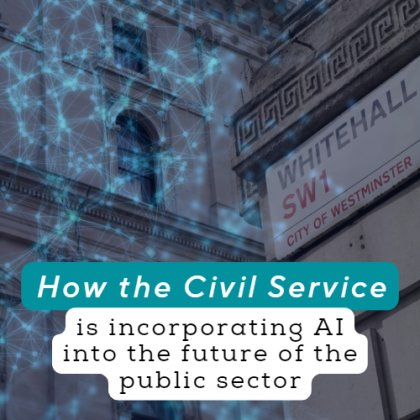Written by Mason Quah, Marketing Assistant
The long-heralded future of work represented by AI has seen success across different areas of the civil service. What sets these successes apart from the less effective attempts to integrate AI into the workforce? Looking at a trio of AIs in use by the UK government shows us how to make the most of the new technology.
AIs can filter information for you
In 2019, the Ministry of Justice was swamped with a massive number of written reports without the manpower to read through them and identify the relevant information across over 250,000 lines of text in 500 reports.
A neural network was trained on a collection of these reports until it could identify patterns in how people filed them. From this, it could then extract the key pieces of information that differed from the more repetitive lines and flag them for a human to read through or search for in a larger catalogue.
AIs can free up time from repetitive tasks
The Government Digital Service encountered its version of this problem when modernising the gov.uk website. Information from over 200 government branches was stored on the site, without a standardised labelling system. The government team in charge of labelling and tagging these 100,000 unsorted pages trained an AI on the pages they had already completed to recognise patterns in the content. The AI was then able to process 96% of the remainder, reducing a task scheduled for several years to 6 months.
AIs can allocate your resources more efficiently
His Majesty’s Passport Office processes over 6 million applications yearly for new or renewed passports and other essential travel documents. An AI system was implemented to allocate incoming applications to the offices with the most capacity for processing them, whether they were across the country or working remotely. Not only did this improve efficiency and reduce error rates but it also improved collaboration between branches.
What do these teach us about AIs in the workplace?
AIs work best with specific types of tasks: One is the type of repetitive work that causes most people’s eyes to glaze over. Another is processing massive amounts of data. In both cases, the machine acts as a force multiplier rather than a replacement for staff. The AI can identify unusual trends that require a person to investigate or automate simple tasks to free up time for more complex projects.
There is a rather infamous story of a hospital that tried using AI to improve its cancer diagnostics. They trained it on a series of medical images taken within the hospital and it reliably agreed with the doctors about which samples were cancerous. When they exported the program for use in other hospitals it became unable to function. It turns out that they had created an image recognition program that checked whether the image was taken in the cancer ward of that particular hospital. When assessing a task for whether an AI could do it we look for three main markers:
- Would it be possible to proofread the AI’s work or follow its line of reasoning?
- Does the task have specific and rigid parameters and goals?
- Is the time effective to train an AI versus handling it manually?
We can apply these questions to the examples we just talked about to see how well they match up. The medical imaging AI failed because doctors did not know what line of reasoning it was using for its decisions. The Gov.uk website overhaul was able to use AI because there was a very specific set of categories that information needed to be matched to and a large set of existing data to train the machine with.
The answers to these three questions will determine whether there is an opportunity for incorporating AIs into the process.

